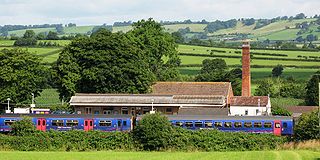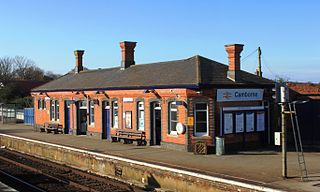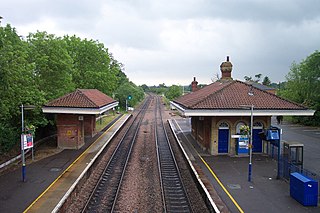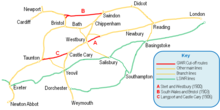
The Wessex Main Line is the railway line from Bristol Temple Meads to Southampton Central. Diverging from this route is the Heart of Wessex Line from Westbury to Weymouth. The Wessex Main Line intersects the Reading to Taunton Line at Westbury and the West of England Main Line at Salisbury.

Pewsey railway station serves the village of Pewsey in the county of Wiltshire, England. The station is on the Berks and Hants line, 75 miles 26 chains measured from the zero point at London Paddington, and served by intercity trains operated by Great Western Railway between London and the West Country. The average journey time to Paddington from Pewsey is just over an hour. Services between Pewsey and Bedwyn, the next station up the line, are infrequent, most eastbound services next calling at Hungerford, Newbury or Reading instead. This is because Bedwyn was the most westerly point of the Network SouthEast on this line, while Pewsey was an InterCity station.

Salisbury railway station serves the city of Salisbury in Wiltshire, England. It is 83 miles 43 chains (134.4 km) from London Waterloo on the West of England line to Exeter St Davids. This is crossed by the Wessex Main Line from Bristol Temple Meads to Southampton Central. The station is operated and served by South Western Railway (SWR), and is also served by Great Western Railway (GWR).

Castle Cary railway station is on the Reading to Taunton line 115.25 miles (185.48 km) south west of London Paddington and the Bristol to Weymouth line 47.75 miles (77 km) south of Bristol Temple Meads. The two routes share tracks between Westbury and Castle Cary stations and are both operated by Great Western Railway, which also manages the station. The station is 1 mile (1.6 km) north of the town of Castle Cary and 5 miles (8 km) south of Shepton Mallet in a largely rural area of Somerset, England.

Westbury railway station serves the town of Westbury in Wiltshire, England. The station is managed by Great Western Railway.

Swindon railway station is on the Great Western Main Line in South West England, serving the town of Swindon, Wiltshire. It is 77 miles 23 chains down the line from the zero point at London Paddington and is situated between Didcot Parkway and Chippenham on the main line. It is managed by Great Western Railway, which also operates all the trains.

Camborne railway station serves the town of Camborne, Cornwall, England. The station is 313 miles (504 km) from London Paddington via Bristol Temple Meads. It is located on Trevu Road in the town, adjacent to a level crossing and the Railway Hotel.

St Erth railway station is a Grade II listed station situated at Rose-an-Grouse in Cornwall, United Kingdom. It serves the nearby village of St Erth, which is about 0.75 miles (1.21 km) away, and is the junction for the St Ives Bay Line to St Ives. The station is 321 miles (517 km) measured from London Paddington via Bristol Temple Meads.

Chippenham railway station is on the Great Western Main Line (GWML) in South West England, serving the town of Chippenham, Wiltshire. It is 93 miles 76 chains down the line from the zero point at London Paddington and is situated between Swindon and Bath Spa on the GWML. The Wessex Main Line diverges from the GWML to the southwest of Chippenham and runs to Trowbridge via Melksham.

Melksham railway station serves the town of Melksham in Wiltshire, England. It is 100 miles 13 chains measured from London Paddington, on the TransWilts Line between Chippenham and Trowbridge that was originally part of the Wilts, Somerset and Weymouth Railway, absorbed in 1850 by the Great Western Railway.

Frome railway station serves a largely rural area of the county of Somerset in England, and is situated in the town of Frome. The station is located on a 1.5 miles (2.4 km) long branch line which loops off the main line railway, which carries services on both the Reading to Taunton line and Bristol to Weymouth route. Most of the trains which take the loop line in order to serve Frome station are on the Bristol to Weymouth route, and most trains on the Reading to Taunton line by-pass the station on the main line. The station is 22.25 miles (36 km) south of Bath Spa on the Bristol to Weymouth line, it is owned by Network Rail and is operated by Great Western Railway.
The Wilts, Somerset and Weymouth Railway (WS&WR) was an early railway company in south-western England. It obtained Parliamentary powers in 1845 to build a railway from near Chippenham to Salisbury and Weymouth. It opened the first part of the network but found it impossible to raise further money and sold its line to the Great Western Railway (GWR) in 1850.
The Devizes branch line was a railway line from Holt Junction, Wiltshire to Patney and Chirton, Wiltshire, and named after Devizes, the largest town on the line. The branch was opened by the Great Western Railway in 1857, and from 1862 when the Reading-Hungerford line reached Devizes it became part of the shortest route from London to the West Country. Those services were re-routed in 1900, and the line closed in 1966.

The Berks and Hants Railway comprised two railway lines built simultaneously by the Great Western Railway (GWR) south and west from Reading in an attempt to keep the London and South Western Railway (LSWR) out of the area that it considered to be its territory in England.
The Langport and Castle Cary Railway is a railway line from Castle Cary railway station to Cogload Junction near Taunton, Somerset, England, which reduced the length of the journey from London to Penzance by 20+1⁄4 miles (32.6 km).

Wilton South railway station is a disused railway station which formerly served Wilton in Wiltshire, England. It was situated on the West of England Main Line from London Waterloo station to Exeter and close to the Great Western Railway’s Wilton station on its Salisbury branch from Westbury.
The Salisbury branch line of the Great Western Railway from Westbury to Salisbury in Wiltshire, England, was completed in 1856. Most of the smaller stations were closed in 1955 but the line remains in use as part of the Wessex Main Line.

Wootton Bassett Junction railway station, formerly Wootton Bassett railway station, was a junction station in Wootton Bassett where the Great Western and South Wales Main Lines diverge. Opened in 1841, it closed in 1965.

Holt Junction was a railway station which served the village of Holt, Wiltshire, England between 1861 and 1966. It stood on the Wessex Main Line at its junction with the western end of the Devizes branch.

The Reading–Taunton line is a major branch of the Great Western Main Line from which it diverges at Reading railway station. It runs to Cogload Junction where it joins the Bristol to Exeter and Penzance line.


















